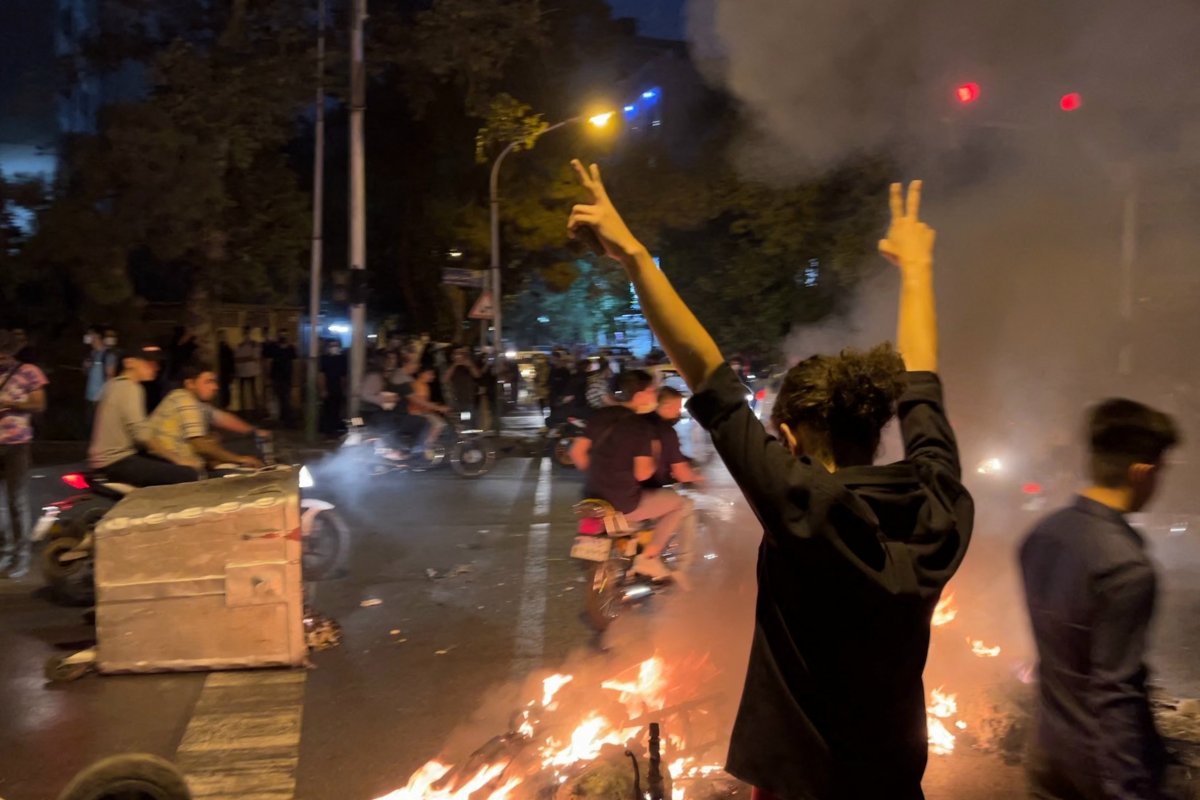When Mahsa Amini was picked up by Iran's notorious morality police on Sept. 13, the 22-year-old had no way of knowing she would spark protests all over Iran. Her 'crime' had been very commonplace: Like thousands of women before her, she was arrested because she was not observing Iran's rules of 'proper hijab,' according to which women have to cover their hair and every part of their body expect for the face and the hands below the wrist. She was taken into a van and beaten up badly, including by blows to her head. Three days later, she died in Tehran's Kasra Hospital.
It was the everyday circumstances of the event that made it so shocking to many Iranians. You'd be hard pressed to find an Iranian of any background who hasn't had a relative arrested due to 'improper hijab.' People from all walks of life knew Mahsa could have been their own sister, daughter, or friend.
Things moved rapidly.
On Sept. 17, Mahsa's funeral in her native Kurdistan province was accompanied by massive protests which soon spread all over the country with slogans that targeted not just the hated morality police but the entire Islamic Republic of Iran. The favorite "death to the dictator" slogan, aimed at Supreme Leader Ali Khamenei, made a comeback, while a new positive slogan was also heard: "Women, Life, Freedom."

At the time of writing, four days have passed, and the protests show no sign of stopping. They've happened in more than 40 cities and at least 19 out of 31 provinces of the country. This makes them the largest protests since 2009. Iran is, once more, in the throes of a nation-wide mass movement with a clear aim of confronting the brutal Islamist dictatorship. Already iconic images are emerging out of the movement that will help define its brazen courage: A woman with a burning scarf in one hand and a stone in another who is wearing a casual shirt with open buttons; another with a pink backpack and green-dyed hair, casually confronting half a dozen uniformed police; a woman in wheel-chair taking off her hijab and burning it to the chants of "we are all in this together." This is a women-led revolution.
For anybody who follows Iran, the fact that women are leading the movement comes as no surprise. Popular footballer Ali Karimi spoke for many when he predicted that Iran's next Kaveh (a national mythical hero) will be a woman. Although it might sound like a cliche, many Iranians have long known the women of the country to be a key hope for change. There is not only historical precedence for this but solid structural reasons behind it: While Iranian women are, on average, more educated than their male counterparts, they live under a regime of oppression, unparalleled anywhere in the world. They can't travel alone or without their husband's permission, their testimony counts as half a person in court, and they are denied the right to such ordinary activities as going to a stadium or smoking a hookah in public. It is thus fitting that they've been at the forefront of movements for change against this regime and that hundreds have spent time in jail for defying the mandatory hijab, which is the most quotidian symbol of the broader repression, but is only one of many forms of activism.
But Mahsa's brutal murder by the state and the ensuing popular anger were only the proximate causes of the protests. The broader roots of the revolt lie in mass revulsion against a regime that has failed to meet even the most basic expectations of its people. The economy is in shambles, and it has been in constant free fall for years. The system is under the crushing weight of corruption, mismanagement, and U.S.-imposed sanctions brought on by the regime's nuclear program, as well as its general animosity toward the West and many of its neighbors.
In the recent years, any semblance of political competition has been crushed. Khamenei is now in total control of the country. The Islamic Revolutionary Guards Corps (IRGC), designated as a terrorist group in the United States and known for its malign activities in the region, now controls vast swathes of Iran's state and economy. It has effectively overtaken the Iranian state. Even the mildest of critics have been removed from all positions of power and many have been jailed. All the regime offers the Iranian people is combination of economic misery, social repression, and political disenfranchisement.
If the regime has survived this long, it is thanks to the sheer brutality it has unleashed on the people, as well as the lack of a coherent alternative. Having repressed all elements of civic or political opposition, it has repeatedly drenched popular protests in blood: In 2009, in 2017-18 and in 2019-20. But any use of force has its limits. What is already noteworthy about the 2022 movement is people are fighting back with more ferocity than ever before. During the 2009 movement, non-violence was the rule. This time around even Nobel Peace Prize laureate Shirin Ebadi reminded the people that they had a right to legitimate defense against oppression. As anger spreads, videos show masses of people attacking the police to rescue those arrested or to simply push them back. A popular slogan threatens: "I will kill those who killed my sister," a play on a slogan of the 1979 revolution that pledged the same for 'my brother.'
Himself an ailing 83-year-old, Khamenei's propensity for meting out violence is well-known. In 1992, fresh into his term as supreme leader, a revolt broke out in his hometown of Mashhad. Khamenei's response was unequivocal: "The counterrevolutionaries are a tiny minority and the police forces must be tough on them. Like weeds, take them out, crush them and throw them out."
Nothing has changed since then. Worries that a popular revolt could lead to civil war, as happened in Syria, have long been present in Iran. But, at some point, a stark question will face the security forces: Should they risk their lives by going out to suppress their fellow Iranians just to safeguard the unpopular rule of Khamenei? An opposition force that could appeal on the security forces and cause a mass defection can be key to an eventual transition to democratic rule.
While Iran still lacks a unified and coherent opposition force, Iranians do enjoy a strong sense of national solidarity that could help bring it about. Mahsa was an ethnic Kurd and the protests initially started in Kurdistan, where Kurdish parties have strong traditions of social action. But they soon spread all over the country including to Tabriz where protesters shouted in the Azeri language: "Azerbaijan is awake; and it supports Kurdistan!" A sense of belonging to a common national home permeates the Iranian society and can explain why the protests quickly spread to cities all over, from the capital Tehran to Caspian Sea cities Rasht and Sari to central cities such as Isfahan and to south-central cities such as Kerman. The job of anti-regime activists, inside and outside the country, is to cohere this national outrage into a political vehicle.
Arash Azizi is an Iranian socialist activist and author of "The Shadow Commander: Soleimani, the US and Iran's Global Ambitions" (Oneworld, 2020). He is a PhD candidate in history at New York University (NYU).
The views in this article are the writer's own.
Uncommon Knowledge
Newsweek is committed to challenging conventional wisdom and finding connections in the search for common ground.
Newsweek is committed to challenging conventional wisdom and finding connections in the search for common ground.
About the writer
To read how Newsweek uses AI as a newsroom tool, Click here.








